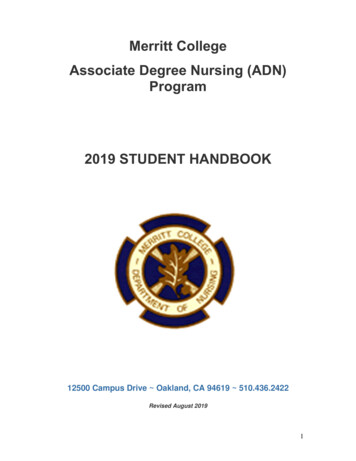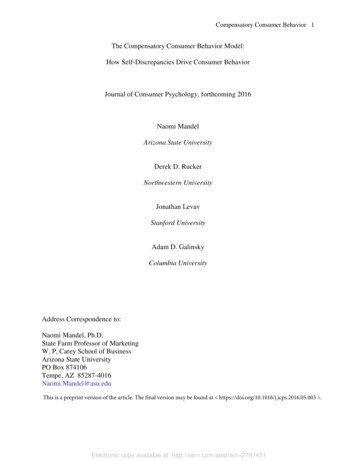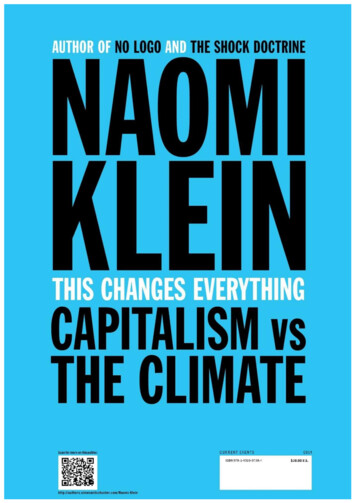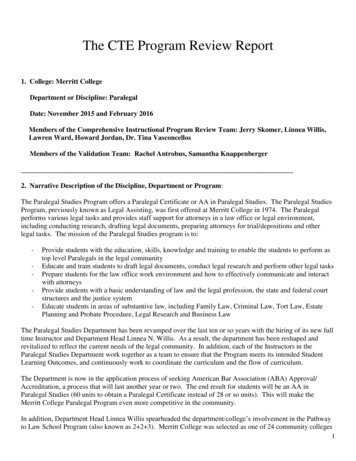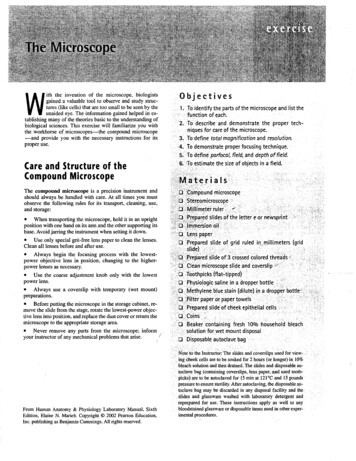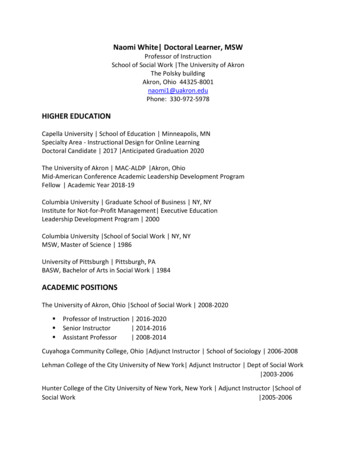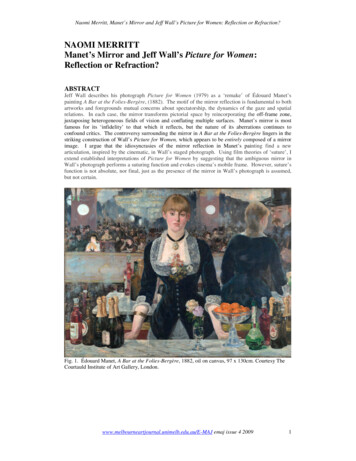
Transcription
Naomi Merritt, Manet’s Mirror and Jeff Wall’s Picture for Women: Reflection or Refraction?NAOMI MERRITTManet’s Mirror and Jeff Wall’s Picture for Women:Reflection or Refraction?ABSTRACTJeff Wall describes his photograph Picture for Women (1979) as a ‘remake’ of Édouard Manet’spainting A Bar at the Folies-Bergère, (1882). The motif of the mirror reflection is fundamental to bothartworks and foregrounds mutual concerns about spectatorship, the dynamics of the gaze and spatialrelations. In each case, the mirror transforms pictorial space by reincorporating the off-frame zone,juxtaposing heterogeneous fields of vision and conflating multiple surfaces. Manet’s mirror is mostfamous for its ‘infidelity’ to that which it reflects, but the nature of its aberrations continues toconfound critics. The controversy surrounding the mirror in A Bar at the Folies-Bergère lingers in thestriking construction of Wall’s Picture for Women, which appears to be entirely composed of a mirrorimage. I argue that the idiosyncrasies of the mirror reflection in Manet’s painting find a newarticulation, inspired by the cinematic, in Wall’s staged photograph. Using film theories of ‘suture’, Iextend established interpretations of Picture for Women by suggesting that the ambiguous mirror inWall’s photograph performs a suturing function and evokes cinema’s mobile frame. However, suture’sfunction is not absolute, nor final, just as the presence of the mirror in Wall’s photograph is assumed,but not certain.Fig. 1. Édouard Manet, A Bar at the Folies-Bergère, 1882, oil on canvas, 97 x 130cm. Courtesy TheCourtauld Institute of Art Gallery, J emaj issue 4 20091
Naomi Merritt, Manet’s Mirror and Jeff Wall’s Picture for Women: Reflection or Refraction?Almost a century separates Canadian artist Jeff Wall’s photograph Picture for Women(1979), from the image that inspired it — Édouard Manet’s painting A Bar at theFolies-Bergère (1882). The motif of the mirror, fundamental to both artworks, hasbeen extensively theorised as foregrounding concerns about spectatorship, thedynamics of the gaze and spatial representation. In both works, the mirror transformspictorial space by reincorporating the ‘off-frame’ zone; by accommodating unseenperspectives in its reflection; through juxtaposing heterogeneous fields of vision, andby conflating multiple surfaces (including that of the picture plane). The mirror is apicture-within-a-picture which enables the absent, concealed and latent to become(metaphorically and literally) present, visible and exposed. Yet, in the case of theBar, the mirror’s revelations are more opaque than transparent: the ‘infidelity’ of themirror image in Manet’s painting has confounded critics for over a century. Thecontroversy and ambiguity surrounding the mirror in A Bar at the Folies-Bergèrelingers in the striking construction of Wall’s Picture for Women, which appears to beentirely composed of a mirror image. What is the significance of Wall’s variation onManet’s theme? It is my contention that the peculiar aberrations of the mirrorreflection in Manet’s painting find a new articulation, inspired by the cinematic, inWall’s staged photograph.A Bar at the Folies-Bergère depicts a scene from ‘Modern’ Parisian life: a youngbarmaid poised behind the bar of a bustling night-club (Fig. 1). The club, its patrons,the barmaid (known as Suzon), the male customer she waits on, the electric lights,assorted liqueur bottles and other trappings of the establishment are reflected in themirror behind the counter. While relatively inconspicuous at a glance, thediscrepancies between the position and appearance of the actual objects in the ‘real’space of the bar and their reflections have attracted much critical debate. Bearingthese complexities in mind, Wall’s Picture for Women offers pictorial integrity,simplicity and transparency (Fig. 2).1 Wall strips back Manet’s composition bystaging his photograph in a drab, non-descript, sparsely furnished classroom. In 1981,Wall described Picture for Women as ‘a kind of classroom lesson on the mechanismsof the erotic’,2 and later in 1985 as ‘a theoretical diagram in an empty classroom.’3These comments suggest that a lesson is to be learned from the picture, enigmatic asthe message may be. In this elusive space of learning, the crowd of the Bar hasdisappeared, leaving only the main protagonists: a young woman, a man and thecamera which, to all appearances, captures the scene reflected in apparent entirety in amirror that shares its surface with the photograph’s picture plane. Extrapolating fromthe central place of the mirror in the Bar, we assume that Wall’s photograph issimilarly structured by a mirror’s reflection. Is this a capricious device, as in Manet’sprovocative original? Can an old mirror learn new tricks?Wall describes Picture for Women as ‘a remake [of Manet’s painting] the way thatmovies are remade’.4 He continues:1Fig. 2. Jeff Wall, Picture for Women, 1979, Cibachrome transparency in light box, 150 x 234 cm.,Vancouver, collection of the effwall/rooms/room1.shtm2Campany, 2007, p. 213Galassi, 2007b, p. 187–1884Wall observed A Bar at the Folies-Bergère, a painting from the collection of the Courtauld Institute inLondon, during his time studying art history at the institute in the 1970s. Galassi, 2007b, p. 188www.melbourneartjournal.unimelb.edu.au/E-MAJ emaj issue 4 20092
Naomi Merritt, Manet’s Mirror and Jeff Wall’s Picture for Women: Reflection or Refraction?The same script is reworked and the appearance, the style, the semiotics,of the earlier film are subjected to a commentary in the new version.This dialectic interests me. It’s a judgment on which elements of the pastare still alive.5Here, Wall borrows the cultural logic of cinema to summarise his engagement withManet’s painting, and in so doing offers up a clue: what can cinema teach us aboutPicture for Women, and also (perhaps unexpectedly) about the conundrums of A Barat the Folies-Bergère? I argue that Wall’s work raises questions about how cinematransformed spectatorship and vision itself. As a means of providing a context for thisclaim, I will draw on Michael Fried’s recent writings on the emergence of a new formof art photography in the late 1970s, and Wall’s central role in these developments.In his 2008 book Why photography matters as art as never before, Michael Friedargues that the late 1970s and early 1980s saw the beginning of a ‘new regime’ in artphotography. This ‘regime’ was marked by two main attributes: the significantlylarger sizes of the images produced (dwarfing those of previous art photography), andthe expectation, or intention, for the works to be hung on a gallery wall (rather thanviewed in books or otherwise as reproductions).6 Fried suggests that the imposingproportions of the new photographic tableaux produced by Wall and other artists suchas Andreas Gursky and Thomas Struth in the 1980s engendered crucial shifts in therelationship between the viewer and artwork. These shifts were not only quantitative(in terms of the increased visual information concomitant with an increase in scale),but also qualitative, in terms of the interaction between spectator and photograph.7In relation to Picture for Women, Fried reads the image’s large scale and itsreferences to Manet’s Bar as indications of a pictorial ambition to be ‘looked at’ inthe same manner as paintings.8 The life-sized photographic transparency provides acommanding ‘to scale’ representation. The woman’s penetrating gaze summons theviewer: her look positions us in front of the image where we regard her as the ‘other’that observes us, or contemplate her image as our own reflection. Here, beholding thephotograph — returning the woman’s gaze — we are paradoxically positioned in thefiring line of the camera itself. In combining these spectatorial dynamics with themesfamiliar from Manet’s painting, Picture for Women seems an ideal example to supportFried’s claim, that ‘issues concerning the relationship between the photograph and theviewer standing before it became crucial for photography as they had neverpreviously been.’9While it is not the intention of this article to revisit Fried’s extensive and influentialwritings on the issue of ‘beholding’ and theatricality in art, I do want to draw attentionhere to one other point raised in Why Photography Matters. In addition to the shiftsin the scale and presentation of photographic images, Fried further observes that artphotography in the 1970s was marked by a head-on engagement with the question of5Galassi, 2007b, p. 188.Fried acknowledges that Jean-François Chevrier was the first to point out that these ‘tableau form’photographs of the 1970s were made for the wall. Fried, 2008, p. 2, 14.7It is ironic that such minute details, such as the reversed text on the camera in the mirror reflection /image of Picture for Women, can prove crucial to the meaning of the image as a whole (as we shalllater see), yet evade representation in most reproductions of the artworks.8Fried, 2008, pp. 16–179Fried, 2008, p. 26www.melbourneartjournal.unimelb.edu.au/E-MAJ emaj issue 4 20093
Naomi Merritt, Manet’s Mirror and Jeff Wall’s Picture for Women: Reflection or Refraction?cinema.10 He identifies Wall as one of the key exponents of this engagement, butacknowledges that an exploration of Wall’s relationship to cinema lies beyond thescope of his book. This is a significant point of departure for my research: I willattempt to address the question of cinema left open by Fried, by considering italongside the problem of spectatorship in Picture for Women and in the controversialpainting it ‘remakes’.A Bar at the Folies-BergèreIn Manet’s painting, A Bar at the Folies-Bergère, the mirror’s presence is madeexplicit through the doubling of objects. Art historian T.J. Clark’s seminal analysis ofthe Bar in his book The Painting of Modern Life identifies a range of pictorialanomalies and spatial aberrations associated with a mismatch between the appearanceand position of the objects (including the barmaid) in the actual space of the scene,and those reflected in the mirror behind the bar. Most puzzlingly, the man inconversation with the barmaid is ‘present’ as a reflection only. It would seem thatthis peculiarity could be resolved by the viewer occupying his position andappropriating his soliciting gaze. Here Manet ingeniously summons the spectatorwhile enlisting their critical faculty: identifying with the man, or adopting his place, isnot a simple solution.In Manet’s painting, the barmaid’s frontal pose and centrally directed gaze positionsthe spectator straight before her, in the middle of the composition. Yet, the reflectionsof the male customer (whose gaze we are encouraged to adopt) and the barmaid (whoreturns his / our gaze) are markedly shifted to the right. As Clark notes, the obliqueangled reflections seem to ‘escape’ their object while the mirror’s frame remainsobstinately parallel to the bar, and indeed to the picture plane. But what is more, thereflections, as a point of identification, escape the spectator too. Consequently, inregards to matters of spectatorship and identification, Clark asserts:We cannot or will not take the place of the gentleman in the top hat, butthere is no other place to occupy, it seems; we are left in a kind ofsuspended relation — to the barmaid, to ourselves as viewers, to thepicture itself as a possible unity.11Are the spectator’s efforts necessarily met with a dead end? Certainly, Clark’sassumption that the painted mirror should faithfully reflect the objects and scene itdepicts will not lead to a satisfactory resolution of these pictorial conundrums. Clarksummarises his concerns about the mirror’s role as follows:The mirror must repeat the picture’s literal surface: it must be the samesurface, only farther back. The thing it must not do is act on the mattersof visual fact it shows; it must not do things to them.12Clark’s analysis illustrates that the mirror has indeed exceeded its role: it does thingsthat would not be possible in reality. He concludes that these accumulatinguncertainties and doubts, which start as ‘a series of limited questions about10Fried, 2008, p. 5Clark, 1984, p. 25112Clark, 1984, p. 25211www.melbourneartjournal.unimelb.edu.au/E-MAJ emaj issue 4 20094
Naomi Merritt, Manet’s Mirror and Jeff Wall’s Picture for Women: Reflection or Refraction?relationships in space’ are likely to end as ‘scepticism about relationship[s] ingeneral.’13 But as Kermit S. Champa astutely observes: ‘Like all of Manet’s bestworks the Bar looks right before it looks wrong, and the latter sensation nevercompletely subverts the former.’14 The sum of a number of individually inconsistentelements creates the strong impression of a mirror: the revelation of multiple points ofview; the doubled (but misaligned) objects; the painterly grey-white scumbling(which suggests the mirror’s tarnish); the loose and impressionistic handling of thepaint in the depiction of the mirror reflection (compared to the more tangible, finerclarity of the ‘actual’ objects). Nonetheless, we can easily amalgamate theseconflicting elements to make sense of the composition. Even if the mirror reflectionis slippery, here its presence is convincing; a claim not so easily applied to Wall’sPicture for Women, as we shall see. Clark concludes that ‘inconsistencies so carefullycontrived must have been felt to be somehow appropriate to the social forms thepainter has chosen to show’; the hypothesis on which his book The Painting ofModern Life as a whole was based.15Ruth E. Iskin extends Clark’s argument (that the painting’s form must be appropriateto the social scene it represents), to consider the development of the modern crowd.16To Iskin, the mismatch between the actual and virtual spaces of the Bar indicates amultitude of gazes or points of view, including that of the barmaid, the male customerand we, the audience, but also of the night-club crowd, seen in the reflection of thelarge room. She argues that the Bar’s famous spatial ‘incoherence’ rests on deeplyingrained cultural assumptions and visual systems:[T]he viewer’s pattern of acculturated vision expects a single viewpoint,based on well-established pictorial codes of Western art. If we perceivethe painting as depicting, indeed of originating from, several viewpointsrather than one, the painting makes sense differently. 17Iskin suggests that Manet’s Bar signifies an important shift in codes of representation:the possibility of a ‘female spectatorial gaze’ which accompanies the ‘exclusivesingle male gaze’, and ‘a new paradigm of crowd spectatorship that includes somewomen alongside men.’18 To Iskin, the painting does not necessarily privilege asingular patriarchal viewpoint (the male customer being but one member of the vastcrowd), or the ‘binary opposition of female spectacle versus a male gaze’.19 Instead,Iskin regards the Bar’s dynamics as more complicated, consisting of a multi-facetedcomposite of views: a mode of representation appropriate to the dynamics of themodern crowd (and an aspect of Manet’s painting which is conspicuously absent fromWall’s Picture for Women).13Clark, 1984, p. 251Collins, 1996, p. 10815Clark, 1984, p. 25216Iskin, 199517Iskin, 1995, p. 1018Iskin, 1995, p. 1019Iskin, 1995, p. 1114www.melbourneartjournal.unimelb.edu.au/E-MAJ emaj issue 4 20095
Naomi Merritt, Manet’s Mirror and Jeff Wall’s Picture for Women: Reflection or Refraction?The Negotiation of Multiple Viewpoints: Cinema’s Mobile FrameWhere, how and why does cinema fit into the conundrums of the Bar and Wall’sphotographic ‘remake’? Iskin argues that the multiple perspectives generated by acrowd are represented in A Bar at the Folies-Bergère by the mirror’s discrepancies.Therefore, to extend Iskin’s thesis we could suggest that the painting (which we viewas a unified whole) is composed of heterogeneous points of view or incongruousfields of vision: the mirror accommodates ‘unseen’ perspectives in its reflection. Thisarrangement resonates with another visual apparatus: cinema’s incorporation ofmultiple view points, which together form the ‘montage chain’.To clarify this analogy, it is necessary to consider the fundamental principles ofclassical cinema. In painting and photography, the frame functions as a fixed dividerof pictorial and non-pictorial fields, although it is also an ambiguous border that isneither inside nor outside the image. Likewise, in cinema the frame divides onscreenfrom off-screen space. But, unique to cinema is the transitory and ephemeral imagewhich moves. Importantly, it is through cinema’s exclusively mobile frame that thepictorial and non-pictorial fields of the film are continually revised. This aspectsignified a radical new mode of representation and prompted the development oftheories of its operation and spectatorship.Classical or continuity editing techniques aim to facilitate a smooth transition and asense of connection between temporally and spatially disjunctive shots. Afundamental example is the shot / reverse-shot technique. Typically, an establishingshot (for example, a long shot of a crowded nightclub with a man weaving throughthe crowd as he approaches the bar) is followed by a shot which orients or givesmeaning to the first (such as a medium shot of a woman behind the bar looking upand leaning forward). We are guided, by convention, to assume a causal or indexicalrelationship between these shots (the barmaid has seen the approaching man andreadies herself to take his order), even though the pair are not present in the sameshot. The spectator’s desire to see and contextualise the next shot helps establish aninterlocking chain in the montage. With exposure and repetition, the audience’sunderstanding of the dynamics of montage becomes established and evolves into anexpectation or learned behaviour associated with film viewing.As the audience’s understanding of filmic conventions becomes more sophisticated,the conventions of film (primarily classical cinema and continuity editing techniques)are naturalised and rendered transparent in the service of narrative development. Theeye-line match technique — a common variation of the shot / reverse-shot pattern —further encourages this dynamic. If, for example, we were presented with a close-upof a man smiling after a medium-shot of a barmaid looking up and leaning forward,we would assume (through learned conventions) that he is ‘returning’ the gaze of thebarmaid. Eye contact is presumed, despite the parties being presented in separateshots. As film theorist Kaja Silverman notes: ‘[T]he gaze which directs our lookseems to belong to a fictional character rather than to the camera.’20 The image of aperson ‘looking’ becomes the motivation or reason for the ‘reverse-shot’ (the viewthe character ‘sees’), which we are subsequently presented with. This spatial andtemporal continuity between shots is assumed (and desired) but not actual, yet the20Silverman, 1983, p. 202www.melbourneartjournal.unimelb.edu.au/E-MAJ emaj issue 4 20096
Naomi Merritt, Manet’s Mirror and Jeff Wall’s Picture for Women: Reflection or Refraction?viewer is efficiently absorbed by the illusion. The gaze and gestures of charactersdirected off-screen, guide the viewer’s attention to a lack, or absence: somethinghinted at but unavailable to the viewer, which they desire to see. The ‘stitching over’of this lack — the re-incorporation of the off-screen space by the movement of theframe or through editing techniques such as shot / reverse-shot — is known in filmtheory as ‘suture’.The Mirror’s Suturing FunctionKaja Silverman describes suture as ‘the name given to the procedures by means ofwhich cinematic texts confer subjectivity upon their viewers.’21 This psychoanalyticterm has been adopted by film theorists to describe the methods by which viewers areencouraged to identify with characters and subsequently become absorbed in(‘stitched’ into) the film’s narrative.22 Suture occurs through editing processes whichfoster a sense of continuity, causality or indexicality between shots; therefore suturingover the gaps in the montage sequence. The shot / reverse-shot pattern describedabove is exemplary in this regard: this process fosters the viewer’s identification withboth the characters and the filmic image, and consequently maintains the integrity ofthe film’s spatial relations by regulating the transformations and transitions betweenoff-screen and on-screen space. Cyclically, the spectator is distanced from the filmicimage in the realisation that visual information is being withheld, then sutured backinto the film with the forthcoming revelation, and back again. With every cut, fade,and dissolve, and through the movements of the camera, the viewer is confronted bythe blind field – the ‘absence’ which accompanies the vision.The mirror in Manet and Wall’s artworks is a potential agent of the suturing process.In a single, still, fixed image like A Bar at the Folies-Bergère and Picture for Women,the mirror mobilises and transforms pictorial space. Its reflection makes unseenobjects or spaces metaphorically present and visible, creating symbolic stand-ins that‘suture’ the lack. For example, in the Bar the woman’s attentive gaze seems directedoutwards, ‘beyond’ the picture itself. The image of the male customer in the mirrorreflection ‘grounds’ this unfixed gaze (‘sutures’ the absence), as we identify with thischaracter and become the recipient of the woman’s look. In turn, we then identifywith the barmaid as she / we receive the male customer’s soliciting gaze. An ongoingoscillation is induced as we switch between points of identification, in a similar wayto cinema’s shot / reverse–shot scenario. What of the perspectives of the crowd thatIskin refers to? Unruly in their diversity and ambiguity, these multiple points of viewsimultaneously compete with each other, even as they are amalgamated within themirror reflection. Consequently, they do not illustrate the concept of suture so neatly.As Clark suggests, when multiple view points are incorporated in a singular, stillimage, such as the Bar, the effect is disorienting. The integrity of the pictorial space21Silverman, 1983, p. 195For the sake of brevity, I have limited my discussion of ‘suture’ to its basic filmic sense, but theterm’s origins should be acknowledged. Originally the term ‘suture’ came from surgical medicine, inwhich it referred to the literal stitching of wounds. The term became associated with psychoanalysiswhen Jacques-Alain Miller [1978] used it in relation to the Lacanian negotiation of lack and desire,through which subjectivity is conferred. Film theorists including Jean-Pierre Oudart [1978], DanielDayan [1974], Stephen Heath [1978], and Kaja Silverman [1983], have adopted the term ‘suture’ andtaken up these Lacanian concepts as a framework for the subject’s relation to the discourse of MAJ emaj issue 4 20097
Naomi Merritt, Manet’s Mirror and Jeff Wall’s Picture for Women: Reflection or Refraction?and the viewer’s position in relation to the image are disturbed. In contrast, multiplepoints of view in a filmic montage are ordered temporally: we make sense of them asthey successively flow before us (recall the shot / reverse-shot scenario where twoprotagonists seemingly interact without being depicted in the same shot).Cinema’s suture system can then be regarded as an oscillation between view pointsover time. The mobile frame and moving picture allow ongoing spatialtransformations and shifts of point of view within the image and through the durationof the shot and montage. Bearing these distinctions in mind, Iskin’s interpretation ofthe Bar as a composite of multiple points of view generated by the crowd, could belogically extended to consider the mirror’s inconsistencies as reflecting multipletemporalities. This argument is posed by Thierry de Duve and Brian Holmes in theirarticle ‘How Manet’s A Bar at the Folies-Bergère is Constructed’ (published threeyears after Iskin’s work), in which the collaborating authors take up (albeit indirectly)the cinematic characteristic of duration as a means of making sense of the Bar’spuzzling discrepancies.Multiple Temporalities as Spatial Disjunctions or ‘Jump Cuts’By way of what they call a ‘demonstration’ (rather than interpretation), based on thelaws of optics and using only the information offered by the finished painting, deDuve and Holmes assert (similarly to Iskin) that the Bar is a composite image,combined not only of multiple viewpoints but also of multiple temporalities:A Bar at the Folies-Bergère is a composite image, or its spatialinconsistencies would not be explicable at all. Either the viewer or themirror moves. In both cases the resulting image conflates two or moremoments in time, unless the viewers – or, at any rate, the viewpoints –multiply simultaneously [ ]23The authors continue, using the photographic notion of the ‘snapshot’, to elucidate theways in which different temporalities are represented in the Bar, thus preserving the‘optical logic’ of the scene:If one presumes that the laws of optics apply, it is far more economical tomake the temporal hypothesis: the painting condenses two distinctmoments or phases of representation – two snapshots, if you will –between which certain things and figures have changed places.24In short, de Duve and Holmes argue for ‘one viewpoint, two moments’.25 Like Clark,they note the apparent (but impossible) ‘rotation’ of the mirror, which would shift thereflection of the figures.However, fixed mirrors do not rotate, and people are mobile. Consequently, de Duveand Holmes regard the spatial inconsistencies in the Bar as representing themovements and changes that occur in a scene over time:23De Duve, Holmes, 1998, p. 146Ibid.25De Duve, Holmes, 1998, p. 14824www.melbourneartjournal.unimelb.edu.au/E-MAJ emaj issue 4 20098
Naomi Merritt, Manet’s Mirror and Jeff Wall’s Picture for Women: Reflection or Refraction?It is the same man who addresses the barmaid from an angle and whomthe barmaid addresses face-to-face, but it is not the same man at the sametime. Only his reflection establishes the equation between two moments.By masking the movement of the mirror, Manet obliterates theirreducible interval of time that separates the man in the top hat fromhimself, in his two successive positions. This temporal gap [ ] cannever be filled by a spatial identification [ ].26 (Emphasis added)This would also account for the altered positions of the bottles on the bar, indicativeof changes incurred in the course of the barmaid’s serving of customers. Therefore,the different moments in time are registered as spatial disjunctions within thepainting. The resulting effect is comparable to a ‘jump cut’ in a film montage — as ifa piece is missing from the flow of an action, leaving two disjointed fragments. Thesediscordant temporal zones are apparently separated by the pictorial field of the mirroritself: the ‘real objects’ (the barmaid, the objects on the counter) in the foreground,inhabit a different temporal ‘space’ from the mirror image. If the Bar is a compositeimage of multiple temporalities or points of view, what is ‘reflected’ in Wall’s mirror?From 1882 to 1979: Picture for WomenIn Picture for Women, the composition implies we are viewing not the ‘real’ space ofthe scene, but only the mirror reflection. The photograph depicts three figures: anattractive young woman (who shares the same slightly melancholy but calm, orperhaps bored, expression and posture of Manet’s barmaid) positioned to the left ofthe centrally placed camera (which commands a sense of presence on a par with thehuman subjects), and a man (the young artist himself) standing to the right side of thephotographic apparatus. The doubling of objects seen in the Bar is absent fromWall’s image. Rather, in Picture for Women the existence of the mirror is implied bythe central camera, combined with frontal framing, and the image of the artistcautiously holding the camera’s cable release (blurred slightly by the movement ofpressing the shutter) which implies his authorship of the representation.In his article ‘The Mainstream and the Crooked Path’, Thierry de Duve considers theproblem of spectatorship in Picture for Women with reference to a birds-eye diagramthat depicts the dynamics between the woman, artist and camera, and the way inwhich the mirror mediates these internal relations.27 A series of ‘looks’ (‘desires’)endlessly ricochet between the three figures and their mirror-images. Despite theillusion of the woman’s eyes meeting our own, her gaze is found to be directed at thecamera’s mirror reflection: the apparent libidinal triangulation therefore existsindependent of the spectator. In accord, David Campany argues that it is notunrealistic to read this artwork as a visual illustration of Laura Mulvey’s groundbreaking article on feminist film theory, ‘Visual Pleasure and Narrative Cinema’(1975), which Wall became familiar with during his time in London in the 1970s.28Employing psychoanalytic theory, Mulvey argued that filmic representations ofwomen are organised by (and for) the voyeuristic male gaze, which for Mulveyepitomised the unconscious of patriarchy. However, if cinema is an image for men,then Wall’s photograph is a ‘picture for women’. De Duve’s diagram of Picture for26De Duve, Holmes, 1998, p. 164De Duve, Pelenc, Groys, 1996, p. 30–3128Mulvey, 197527www.melbourneartjournal.unimelb.edu.au/E-MAJ emaj issue 4 20099
Naomi Merritt, Manet’s Mirror and Jeff Wall’s Picture for Women: Reflection or Refraction?Women suggests Wall challenges the dynamics of patriarchal voyeurism: an argumenthe premises on the image as mirror-reflection. De Duve argues that by imagining thescene from a birds-eye perspective (‘outside’ the image), it b
reflection in Manet’s painting find a new articulation, inspired by the cinematic, in Wall’s staged photograph. A Bar at the Folies-Bergère depicts a scene from ‘Modern’ Parisian life: a young barmaid poised behind the bar of a bustling
